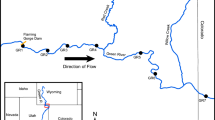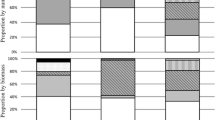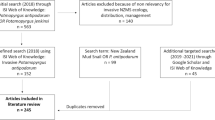Abstract
Biological invasions represent a relevant ecological and economic problem of our globalized world. While a few species have been classified as invasive due to their ecological and economic impacts on the invaded ecosystems (e.g., zebra mussel), others show contrasting invasive potential, depending on the invaded ecosystem and/or the traits of the exotic species. This paper reviews the worldwide distribution, ecological impacts and the reasons that explain the invasive success of the aquatic mud snail Potamopyrgus antipodarum Gray (Hydrobiidae, Mollusca), which is native to New Zealand. This review shows that most studies on P. antipodarum distribution have been conducted in Europe, North America and Australia, and few studies in Asia. The distribution of this snail is still unknown in other parts of the world (e.g., Africa, South and Central America). The range of invaded aquatic ecosystems varies from fresh to salt water and from lentic to lotic ecosystems. The ecological impact of this species is due to the fast population growth rate and to the extremely high densities that it can reach, leading to altered C and N cycles in invaded ecosystems. However, at low densities mud snails have been shown to enhance secondary production. Additionally, P. antipodarum has been found to overcome the negative effects of predators and parasites (e.g., it survives the pass through the digestive tracts of fish). This review contributes to assess the magnitude and ecological risk of P. antipodarum invasion throughout the world.
Similar content being viewed by others
References
Alonso A (2005) Valoración de la degradación ambiental y efectos ecotoxicológicos sobre la comunidad de macroinvertebrados bentónicos en la cabecera del río Henares. Dissertation, Universiy of Alcala, Spain
Alonso A, Camargo JA (2003) Short-term toxicity of ammonia, nitrite and nitrate to the aquatic snail Potamopyrgus antipodarum (Hydrobiidae, Mollusca). Bull Environ Contam Toxicol 70:1006–1012
Alonso A, Castro-Díez P (2008) What explains the invading success of the aquatic mud snail Potamopyrgus antipodarum (Hydrobiidae, Mollusca)? Hydrobiologia 614:107–116
Arango CP, Riley LA, Tank JL, Hall RO Jr (2009) Herbivory by an invasive snail increases nitrogen fixation in a nitrogen-limited stream. Can J Fish Aquat Sci 66:1309–1317
Baur B, Schmidlin S (2007) Effects of invasive non-native species on the native biodiversity in the river Rhine. In: Netwing W (ed) Biological invasions. Ecological studies, vol 193. Springer, Heidelberg, pp 257–273
Bowler PA (1991) The rapid spread of the freshwater Hydrobiid snail Potamopyrgus antipodarum (Gray) in the Middle Snake River, Southern ID. Proc Desert Fishes Counc 21:173–182
Boycott AE (1936) The habitats of freshwater mollusca in Britain. J Anim Ecol 5:111–186
Brenneis VEF, Sih A, de Rivera CE (2010) Coexistence in the intertidal: interactions between the non-indigenous New Zealand mud snail Potamopyrgus antipodarum and the native estuarine isopod Gnorimosphaeroma insulare. Oikos 119:1755–1764
Brzeziński T, Kołodziejczyk A (2001) Distribution of Potamopyrgus antipodarum (Gray, 1843) in waters of the Wigry National Park (NE, Poland) and their effect of selected habitat factors on its occurrence. Folia Malacol 9:125–135
Carlsson R (2000) The distribution of the gastropods Theodoxus fluviatilis (L.) and Potamopyrgus antipodarum (Gray) in lakes on the Aland Islands, south-western Finland. Boreal Environ Res 5:187–195
Carlsson NOL, Brönmark C, Hansson L-A (2004) Invading herbivory: the golden apple snail alters ecosystem functioning in Asian wetlands. Ecology 85:1575–1580
Cianfanelli S, Lori E, Bodon M (2007) Non-indigenous freshwater molluscs and their distribution in Italy. In: Gherardi F (ed) Biological invaders in inland waters: profiles, distribution, and threats. Springer, Dordrecht
Costil K, Dussart GBJ, Daguzan J (2001) Parameters structuring populations of aquatic gastropods in the region of Mont Saint-Michel (France). Biodivers Conserv 10:1–18
Cross WF, Rosi-Marshall EJ, Behn KE, Kennedy TA, Hall RO Jr, Fuller AE, Baxter CV (2010) Invasion and production of New Zealand mud snails in the Colorado River, Glen Canyon. Biol Invasions 12:3033–3043
Davidson TM, Brenneis VEF, de Rivera C, Draheim R, Gillespie GE (2008) Northern range expansion and coastal occurrences of the New Zealand mud snail Potamopyrgus antipodarum (Gray, 1843) in the northeast Pacific. Aquat Invasions 3:349–353
Dorgelo J (1987) Density fluctuations in populations (1982–1986) and biological observations of Potamopyrgus jenkinsi in two trophically differing lakes. Hydrobiol Bull (Amsterdam) 21:95–110
Dorgelo J, Leonards PEG (2001) Relationship between C/N ratio of food types and growth rate in the snail Potamopyrgus jenkinsi (E. A. Smith). J N Am Benthol Soc 20:60–67
Duft M, Schulte-Oehlmann U, Tillman M, Markert B, Oehlmann J (2003a) Toxicity of triphenyltin and tributyltin to the freshwater mud snail Potamopyrgus antipodarum in a new sediment biotest. Environ Toxicol Chem 22:145–152
Duft M, Schulte-Oehlmann U, Weltje L, Tillmann M, Oehlmann J (2003b) Stimulated embryo production as a parameter of estrogenic exposure via sediments in the freshwater mud snail Potamopyrgus antipodarum. Aquat Toxicol 64:437–449
Dukes JS, Mooney HA (1999) Does global change increase the success of biological invaders? Trends Ecol Evol 14:135–139
Dybdahl MF, Drown DM (2011) The absence of genotypic diversity in a successful parthenogenetic invader. Biol Invasions 13:1663–1672
Filippenko DP, Son MO (2008) The New Zealand mud snail Potamopyrgus antipodarum (Gray, 1843) is colonising the artificial lakes of Kaliningrad City, Russia (Baltic Sea Coast). Aquat Invasions 3:345–347
Gangloff MM (1998) The New Zealand mud snail in Western North America. Aquat Nuis Species 2:25–30
Gérard C, Blanc A, Costil K (2003) Potamopyrgus antipodarum (Mollusca: Hydrobiidae) in continental aquatic gastropod communities: impact of salinity and trematode parasitism. Hydrobiologia 493:167–172
Gherardi F (2007) Biological invaders in inland waters: profiles, distribution, and threats. Springer, Dordrecht
Grant A, Briggs A (1998) Toxicity of ivermectin to estuarine and marine invertebrates. Mar Pollut Bull 36:540–541
Grigorovich IA, Korniushin AV, Gray DK, Duggan IC, Colautti RI, MacIsaac HJ (2003) Lake Superior: an invasion cold spot? Hydrobiologia 499:191–210
Hall RO Jr, Tank JL, Dybdahl MF (2003) Exotic snails dominate nitrogen and carbon cycling in a highly productive stream. Front Ecol Environ 1:407–411
Hall RO Jr, Dybdahl MF, VanderLoop MC (2006) Extremely high secondary production of introduced snails in rivers. Ecol Appl 16:1121–1131
Hellmair M, Goldsmith G, Kinziger AP (2011) Preying on invasives: the exotic New Zealand mud snail in the diet of the endangered tidewater goby. Biol Invasions 13:2197–2201
Herbst DB, Bogan MT, Lusardi RA (2008) Low specific conductivity limits growth and survival of the New Zealand mud snail from the upper Owens RIVER, California. West North Am Nat 68:324–333
Hershler R, Liu H-P, Clark WH (2010) Microsatellite evidence of invasion and rapid spread of divergent New Zealand mud snail (Potamopyrgus antipodarum) clones in the Snake River basin, ID, USA. Biol Invasions 12:1521–1532
Hess AD, Hayes RO (1970) Relative potentials of domestic animals for zooprophylaxis against mosquito vectors of encephalitis. Am J Trop Med Hyg 19:327–334
Heywood J, Edwards RW (1962) Some aspects of the ecology of Potamopyrgus jenkinsi Smith. J Anim Ecol 31:239–250
Huebner G, Braukmann U (2005) On the development of the sweet water molluscs (Gastropoda and Bivalvia) in the river basin of the lower Werra. Philippia 12:125–136
Jensen A, Forbes VE, Parker D Jr (2001) Variation in cadmium uptake, feeding rate, and life-history effects in the gastropod Potamopyrgus antipodarum: linking toxicant effects on individuals to the population level. Environ Toxicol Chem 20:2503–2513
Jokela J, Lively CM, Dybdahl ME, Fox JA (1997) Evidence for a cost of sex in the freshwater snail Potamopyrgus antipodarum. Ecology 78:452–460
Kabat AR, Hershler R (1993) The prosobranch snail family Hydrobiidae (Gastropoda: Rissoidae): review of classification and supraspecific taxa. Smithson Contributions Zool 547:94
Kerans BL, Dybdahl MF, Gangloff MM, Jannot JE (2005) Potamopyrgus antipodarum: distribution, density, and effects on native macroinvertebrate assemblages in the Greater Yellowstone ecosystem. J N Am Benthol Soc 24:123–138
Kolar CS, Lodge DM (2001) Progress in invasion biology: predicting invaders. Trends Ecol Evol 16:199–204
Kołodziejczyk A, Lewandowski K, Stańczykowska A (2009) Long-term changes of mollusc assemblages in bottom sediments of small semi-isolated lakes of different trophic state. Pol J Ecol 57:331–339
Kopp K, Jokela J (2007) Resistant invaders can convey benefits to native species. Oikos 116:295–301
Left LG, Burch JL, McArthur JV (1990) Spatial distribution, seston removal, and potential competitive interactions of the bivalves Corbicula fluminea and Elliptio complanata in a coastal plain stream. Freshw Biol 24:409–416
Levri EP, Kelly AA, Love E (2007) The invasive New Zealand mud snail (Potamopyrgus antipodarum) in Lake Erie. J Gt Lakes Res 33:1–6
Levri EP, Dermott RM, Lunnen SJ, Kelly AA, Ladson T (2008) The distribution of the invasive New Zealand mud snail (Potamopyrgus antipodarum) in Lake Ontario. Aquat Ecosyst Health Manag 11:412–421
Lewin I, Smolinski A (2006) Rare and vulnerable species in the mollusc communities in the mining subsidence reservoirs of an industrial area (The Katowicka Upland, Upper Silesia, Southern Poland). Limnologica 36:181–191
Lively CM (1987) Evidence from a New Zealand snail for the maintenance of sex by parasitism. Nature 328:519–521
Loo SE, Keller RP, Leung B (2007a) Freshwater invasions: using historical data to analyse spread. Divers Distrib 13:23–32
Loo SE, Nally RM, Lake PS (2007b) Forecasting New Zealand mud snail invasion range: model comparisons using native and invaded ranges. Ecol Appl 17:181–189
Lowe S, Browne M, Boudjelas S, De Poorter M (2000) 100 of the world’s worst invasive alien species a selection from the global invasive species database. Published by the Invasive Species Specialist Group (ISSG) a specialist group of the Species Survival Commission (SSC) of the world conservation union (IUCN), p 12. First published as special lift-out in Aliens Dec 12th 2000. (Updated and reprinted version)
Marshall JW, Winterbourn MJ (1979) An ecological study of a small New Zealand stream with particular reference to the oligochaeta. Hydrobiologia 65:199–208
Møller V, Forbes VE, Depledge MH (1994) Influence of acclimation and exposure temperature on the acute toxicity of cadmium to the freshwater snail Potamopyrgus antipodarum (Hydrobiidae). Environ Toxicol Chem 13:1519–1524
Mouthon J, Dubois JP (2001) Mollusc communities of the littoral zone of Annecy Lake (Savoie, France). Ann Limnol Int J Limnol 37:267–276
Múrria C, Bonada N, Prat N (2008) Effects of the invasive species Potamopyrgus antipodarum (Hydrobiidae, Mollusca) on community structure in a small Mediterranean stream. Fundam Appl Limnol 171:131–143
Naser MD, Son MO (2009) First record of the New Zealand mud snail Potamopyrgus antipodarum (Gray 1843) from Iraq: the start of expansion to Western Asia? Aquat Invasions 4:369–372
Netwing W (2007) Biological invasions: why it matters. In: Netwing W (ed) Biological invasions. Ecological studies, vol 193. Springer, Heidelberg, pp 1–6
Pérez-Quintero JC (2009) Freshwater molluscs from the biosphere reserve “Dehesas de Sierra Morena”, SW Iberian Peninsula. Iberus 27:1–18
Ponder WF (1988) Potamopyrgus antipodarum, a molluscan colonizer of Europe and Australia. J Molluscan Stud 54:271–286
Radea C, Louvrou I, Economou-Amilli A (2008) First record of the New Zealand mud snail Potamopyrgus antipodarum J.E. Gray 1843 (Mollusca: Hydrobiidae) in Greece—Notes on its population structure and associated microalgae. Aquat Invasions 3:341–344
Richards DC (2002) The New Zealand mud snail invades the Western United States. Aquat Nuis Species 4:42–44
Richards DC (2004) Competition between the threatened bliss rapids snail, Taylorconcha serpenticola (Hershler et al.) and the invasive, aquatic snail, Potamopyrgus antipodarum (Gray). Dissertation, Montana State University
Richards DC, Cazier LD, Lester GT (2001) Spatial distribution of three snail species, including the invader Potamopyrgus antipodarum, in a freshwater spring. Western North Am Nat 61:375–380
Riley LA, Dybdahl MF, Hall RO Jr (2008) Invasive species impact: asymmetric interactions between invasive and endemic freshwater snails. J N Am Benthol Soc 27:509–520
Ross RM, Lellis WA, Bennett RM, Johnson CS (2001) Landscape determinants of nonindigenous fish invasions. Biol Invasions 3:347–361
Sakai AK, Allendorf FW, Holt JS, Lodge DM, Molofsky J, With KA, Baughman S, Cabin RJ, Cohen JE, Ellstrand NC, McCauley DE, O’Neil P, Parker IM, Thompson JN, Weller SG (2001) The population biology of invasive species. Annu Rev Ecol Evol Syst 32:305–332
Schmidlin S, Schmera D, Baur B (2012) Alien molluscs affect the composition and diversity of native macroinvertebrates in a sandy flat of Lake Neuchâtel, Switzerland. Hydrobiologia 679:233–249
Schreiber ESG, Glaister A, Quinn GP, Lake PS (1998) Life history and population dynamics of the exotic snail Potamopyrgus antipodarum (Prosobranchia: Hydrobiidae) in lake Purrumbete, Victoria, Australia. Mar Freshw Res 49:73–78
Schreiber ESG, Lake PS, Quinn GP (2002) Facilitation of native stream fauna by an invading species? Experimental investigations of the interaction of the snail, Potamopyrgus antipodarum (Hydrobiidae) with native benthic fauna. Biol Invasions 4:317–325
Schreiber ESG, Quinn GP, Lake PS (2003) Distribution of an alien aquatic snail in relation to flow variability, human activities and water quality. Freshw Biol 48:951–961
Shimada K, Urabe M (2003) Comparative ecology of the alien freshwater snail Potamopyrgus antipodarum and the indigenous snail Semisulcospira spp. Venus (Tokyo) 62:39–53
Simoes M (1988) Distribución en Portugal de Potamopyrgus jenkinsi (Prosobranchia Hydrobiidae). Iberus 8:243–244
Soler J, Moreno D, Araujo R, Ramos MA (2006) Diversidad y distribución de los moluscos de agua dulce en la Comunidad de Madrid (España). Graellsia 62:201–252
Son MO, Nabozhenko MV, Shokhin IV (2008) The Don River basin is a new stage of expansion of Potamopyrgus jenkinsi (Smith, 1889) (Gastropoda, Hydrobioidea) in Europe. Dokl Biol Sci 419:129–130
Sousa R, Guilhermino L, Antunes C (2005) Molluscan fauna in the freshwater tidal area of the River Minho estuary, NW of Iberian Peninsula. Ann Limnol Int J Limnol 41:141–147
Strayer DL (1999) Effects of alien species on freshwater molluscs in North America. J N Am Benthol Soc 18:74–98
Strzelec M (2005) Impact of the introduced Potamopyrgus antipodarum (Gastropoda) on the snail fauna in post-industrial ponds in Poland. Biologia 60:159–163
Thomsen MS, Wernberg T, Silliman BR, Josefson AB (2009) Broad-scale patters of abundance of non-indigenous soft-bottom invertebrates in Denmark. Helgoland Mar Res 63:159–167
Torchin ME, Lafferty KD, Dobson AP, McKenzie VJ, Kuris AM (2003) Introduced species and their missing parasites. Nature 421:628–630
Van den Berg MS, Coops H, Noordhuis R, van Schie J, Simons J (1997) Macroinvertebrate communities in relation to submerged vegetation in two Chara-dominated lakes. Hydrobiologia 342:143–150
Vinson MR, Baker MA (2008) Poor growth of rainbow trout fed New Zealand mud snails Potamopyrgus antipodarum. North Am J Fish Manag 28:701–709
Wagner S (2000) Mollusc population in the main river near Muehlheim/Dietesheim, Germany. Mitteilungen der Deutschen Malakozoologischen Gesellschaft 65:23–33
Weatherhead MA, James MR (2001) Distribution of macroinvertebrates in relation to physical and biological variables in the littoral zone of nine New Zealand lakes. Hydrobiologia 462:115–129
Weetman D, Hauser L, Carvalho GR (2002) Reconstruction of microsatellite mutation history reveals a strong and consistent deletion bias in invasive clonal snails, Potamopyrgus antipodarum. Genetics 162:813–822
Weetman D, Hauser L, Carvalho GR (2006) Heterogeneous evolution of microsatellites revealed by reconstruction of recent mutation history in an invasive apomictic snail, Potamopyrgus antipodarum. Genetica 127:285–293
Werner H, Boeters HD, Guenther A (1994) On the freshwater mollusc fauna in the Spanish province of Cuenca. Malakologische Abhandlungen (Dresden) 17:1–9
Williamson M, Fitter A (1996) The varying success of invaders. Ecology 77:1661–1666
Winterbourn MJ (1970) The New Zealand species of Potamopyrgus (Gastropoda: Hydrobiidae). Malacologia 10:283–321
Winterbourn MJ (1973) A guide to the freshwater mollusca of New Zealand. Tuatara 20:141–159
Zambrano L, Valiente E, Zanden MJV (2010) Food web overlap among native axolotl (Ambystoma mexicanum) and two exotic fishes: carp (Cyprinus carpio) and tilapia (Oreochromis niloticus) in Xochimilco, Mexico City. Biol Invasions 12:3061–3069
Zaranko DT, Farara DG, Thompson FG (1997) Another exotic mollusc in the Laurentian Great Lakes: the New Zealand native Potamopyrgus antipodarum (Gray 1843) (Gastropoda, Hydrobiidae). Can J Fish Aquat Sci 54:809–814
Zbikowski J, Zbikowska E (2009) Invaders of an invader: trematodes in Potamopyrgus antipodarum in Poland. J Invertebr Pathol 101:67–70
Zettler ML, Richard D (2004) Freshwater molluscs from Corsica. Notated collections from summer 2003 with emphasis on Theodoxus fluviatilis. Malakologische Abhandlungen (Dresden) 22:3–16
Zieritz A, Waringer J (2008) Distribution patterns and habitat characterization of aquatic Mollusca in the Weidlingbach near Vienna, Austria. Arch fuer Hydrobiol Suppl 166:271–292
Acknowledgments
This research was funded by the Spanish Ministry of Science and Innovation (SMSI) (CGL2010-16388/BOS) and by the Castilla-La Mancha Community (POII10-0179-470). The University of Alcalá provided logistical support. Dr. Álvaro Alonso was supported by a Juan de la Cierva contract from the SMSI at University of Alcalá. We want to express our sincere gratitude to four anonymous reviewers for their comments to improve this manuscript.
Author information
Authors and Affiliations
Corresponding author
Rights and permissions
About this article
Cite this article
Alonso, Á., Castro-Díez, P. The exotic aquatic mud snail Potamopyrgus antipodarum (Hydrobiidae, Mollusca): state of the art of a worldwide invasion. Aquat Sci 74, 375–383 (2012). https://doi.org/10.1007/s00027-012-0254-7
Received:
Accepted:
Published:
Issue Date:
DOI: https://doi.org/10.1007/s00027-012-0254-7




